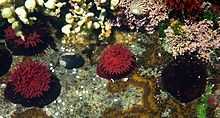Actinia tenebrosa
| Actinia tenebrosa | |
|---|---|
 | |
| Scientific classification | |
| Kingdom: | Animalia |
| Phylum: | Cnidaria |
| Class: | Anthozoa |
| Order: | Actiniaria |
| Family: | Actiniidae |
| Genus: | Actinia |
| Species: | A. tenebrosa |
| Binomial name | |
| Actinia tenebrosa Farquhar, 1898 [1] | |
The Waratah anemone, Actinia tenebrosa is the most common species of sea anemone found in the waters of eastern Australia, and New Zealand. It is found relatively high on the seashore, in rock pools, and various cracks and shaded surfaces such as under rock overhangs in the intertidal zone.
Description
When underwater this sea anemone opens up to display numerous tentacles, arranged in three whorls. Out of water, the tentacles retract and the anemone closes to resemble a dome shaped red, crimson, brown, green or black blob of jelly, about 4 cm (1.6 in) across and 2.7 cm (1 in) high. This species was first described in 1898 by H Farquhar who wrote "Full-grown individuals in situations well exposed to the rays of the sun have a column greenish or brownish black, and the disc and tentacles dusky crimson, while those on the undersides of overhanging stones are reddish brown or crimson, the depth of colour varying according to the amount of light which reaches them."[2] Actinia tenebrosa is similar in form to the beadlet anemone (Actinia equina) of the northern hemisphere. The column has a number of iridescent blue spherules armed with nematocysts.[3]
Distribution and habitat
The Waratah anemone is found from along the coasts of southern Australia, its range extending from Perth to New South Wales. It is also found throughout New Zealand. It is found in cracks and crevices, under overhangs and under boulders on rocky shores, usually in the middle to low intertidal zone but occasionally higher up the shore.[3]
Biology
This species is viviparous and broods its young inside its body cavity. When the offspring are well-developed they are expelled through the mouth. The juveniles often attach themselves to rocks in close proximity to the parent forming clonal clusters.[4] When these anemones are growing alongside each other they appear to know whether or not they are closely related. If they are, they will tolerate each other's close presence while if they are unrelated, they will attack each other.[3] The Waratah anemone can also reproduce sexually with planktonic larvae settling far away from the parent individual. It may be difficult for these juveniles to establish themselves because of resident populations of cloned individuals that are highly locally adapted.[5]
References
- ↑ Daphne Fautin (2010). "Actinia tenebrosa Farquhar, 1898". World Register of Marine Species. Retrieved 21 January 2011.
- ↑ H. Farquhar (1898). "Preliminary account of some New-Zealand Actiniaria". Journal of the Linnean Society of London, Zoology 26 (171): 535. doi:10.1111/j.1096-3642.1898.tb00409.x.
- ↑ 3.0 3.1 3.2 Davey, Keith (2000). "Waratah Anemone Actinia tenebrosa". Life on Australian seashores. Retrieved 2013-12-01.
- ↑ Dakin, W. J. (1952). Australian Seashores. p. 136.
- ↑ Ayre, David J. (1985). "Localized Adaptation of Clones of the Sea Anemone Actinia tenebrosa". Evolution 39 (6): 1250–1260. JSTOR 2408782.
| Wikimedia Commons has media related to Actinia tenebrosa. |